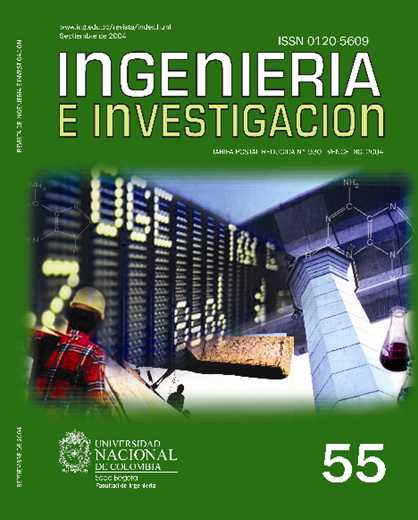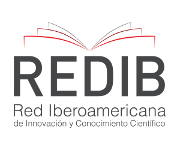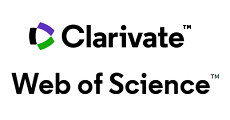Alternatives for clarifying glucose syrup obtained by enzymatic hydrolysis of starch
Alternativas para la clarificación del jarabe de glucosa obtenido por hidrólisis enzimática del almidón
DOI:
https://doi.org/10.15446/ing.investig.v24n2.14595Keywords:
separation, purification, hydrolysis, enzyme, removal, clarification, concentration, starch, glucose, syrup (en)separación, filtración, purificación, hidrólisis, enzimas, remoción, clarificación, concentración, almidón, jarabe, glucosa (es)
Downloads
The present paper studies some routes for separating and purifying glucose syrup obtained by enzymatic hydrolysis of potato starch. The clarifying process is done in three stages. The first one (solids remotion) is done by applying conventional solid-liquid separation techniques such as sedimentation, centrifugation and filtration, as well as studying the effect of using flocculant and coagulant agents, prior to the already mentioned operations. Purification is done by adding decoloring agents, followed by ultrafiltration of the syrup. The last step (concentration) is done by vacuum evaporation. The results showed that separation, centrifuging and sedimentation reached 50% yield whilst filtration and ultrafiltration achieved 78% and 98% respectively. It was found that adsorbent agents such as activated carbon and diatomaceous earth were effective in removing color during the purification stage. The most suitable alternative for separation can be suggested from the foregoing, allowing a syrup to be obtained having similar characteristics and properties to the commercial product. The most appropriate technological module for carrying out the operation is also represented.
El presente artículo estudia algunas rutas para la separación y purificación del jarabe de glucosa obtenido por la hidrólisis enzimática del almidón de papa. El proceso de clarificación se realiza en tres etapas. La primera de ellas, la remoción de sólidos, se lleva a cabo con la aplicación de técnicas convencionales de separación sólido líquido como la sedimentación, centrifugación y filtración, estudiando, además, el efecto de utilizar agentes floculantes y coagulantes, previo a las operaciones ya mencionadas. La segunda etapa, la purificación, se hace con la adición de agentes decolorantes y posterior ultrafiltración del jarabe. Finalmente, la concentración, se efectúa por evaporación al vacío. Los resultados mostraron cómo las técnicas de separación, centrifugación y sedimentación alcanzaron porcentajes de rendimiento del orden del 50%, mientras que con técnicas de filtración y ultrafiltración, se obtuvieron porcentajes del 78 y 98%, respectivamente; en la etapa de purificación se encontró, que los agentes adsorbentes como el carbón activado y las tierras diatomáceas son efectivos en la remoción de color. Con lo anterior se logró plantear finalmente la alternativa de separación más adecuada que permitió la obtención de un jarabe con características y propiedades similares al producto comercial. Se presenta además el módulo tecnológico más apropiado para llevar a cabo la operación.
References
Cruz, G., Rentería, A., “Estudio de algunas rutas para la separación y purificación del jarabe de glucosa obtenido por hidrólisis enzimática del almidón”, Proyecto de grado para optar al título de ingeniero químico, Universidad Nacional de Colombia, Bogotá, 2001.
Cyquim de Colombia, Cytec industries Inc. Water Treating Chemicals. 2000.
Equiacero Ltda. Compañía Industrial Equipos Inoxidables, Bogotá, 2001.
González, G. y Castellanos O., “Incidencia del análisis de mercados en el desarrollo de la ingeniería de enzimas en Colombia. Caso hidrólisis enzimática del almidón”, Ingeniería y Sociedad, edición No. 6, Universidad Nacional de Colombia, Bogotá, 2000.
Habib Arkady Limited. Habib Group of Industries. arkady@habibgroup.com. Pakistán, 1999.
lbarz, A.; Barbosa, G.; Garza, S. y Gimeno, V., Métodos experimentales en la ingeniería alimentaria, Editorial Acribia, S.A., Zaragoza, 2000.
Imsa. Productos derivados del maíz. https://www.imsa.com.mx. 2001.
Industrias del maíz, S.A. Corn Products International. Cali, 1996.
Márquez, M. y Fernández, V., Los hidrolizados enzimáticos de alimentos y su aplicación en la industria alimentaria. Alimentación equipos y tecnología, Madrid, 1992.
Mc. Ginnis, R., Beet Sugar Technology, Reinhold Publishing Corporation, New York, 1971.
Millipore Corporation, https://www.millipore.com. 2000.
Normas Usp 23 NF 18, The United States Pharmacopeia Convention, INC. The National Formulary, 1995.
Novo Nordisk A/S, B 248c-GB 1000, abril 1995.
Novo Nordisk A/S, B 552f-GB, junio 1997.
Peri, C, Riva, M, y Decio. P, “Crossflow Membrane Filtration of Wines: Comparison of Performance of Ultrafiltration, Microfiltration, and Intermediate Cut-Off Membranes”, en Am.J.Enoi.Vitic., vol. 39, No. 2, 1988. DOI: https://doi.org/10.5344/ajev.1988.39.2.162
RAR. Refinerías de Azúcar Reunidas S.A. Sugar decolorization, Portugal. 1999.
Rundell, J., Pottage, P y Ronald, J., U.S Patent 4,345,947. Clarification of Glucose Syrups, Aug 1982.
Singh, N., “International Congress on Membranes and Membrane Processes”, Toronto, Canada, 1999.
Singh, N., “Microfiltration of corn starch hydrolysate using ceramic membranes”, Ph.D. Thesis, University of Illinois UMI Catalog 9812774, 1999.
Skoog, D., Química Analítica, Editorial McGraw-Hill. Sexta edición, México, 1995.
Tejada, A.; Montesinos, R. y Guzmán, R., Bioseparaciones, Editorial Unison. México, 1995.
Ullman, F., Enciclopedia de Química Industrial, Gustavo Hill, Barcelona, 1990.
How to Cite
APA
ACM
ACS
ABNT
Chicago
Harvard
IEEE
MLA
Turabian
Vancouver
Download Citation
CrossRef Cited-by
1. I. Biasato, S. Bellezza Oddon, Z. Loiotine, A. Resconi, L. Gasco. (2024). Wheat starch processing by-products as rearing substrate for black soldier fly: does the rearing scale matter?. animal, 18(8), p.101238. https://doi.org/10.1016/j.animal.2024.101238.
Dimensions
PlumX
Article abstract page views
Downloads
License
Copyright (c) 2004 Gloria Teresa Cruz Guerrero, Gloria Helena González Blair, Andira Yesil Rentería Ayala, Óscar Fernando Castellanos Domínguez

This work is licensed under a Creative Commons Attribution 4.0 International License.
The authors or holders of the copyright for each article hereby confer exclusive, limited and free authorization on the Universidad Nacional de Colombia's journal Ingeniería e Investigación concerning the aforementioned article which, once it has been evaluated and approved, will be submitted for publication, in line with the following items:
1. The version which has been corrected according to the evaluators' suggestions will be remitted and it will be made clear whether the aforementioned article is an unedited document regarding which the rights to be authorized are held and total responsibility will be assumed by the authors for the content of the work being submitted to Ingeniería e Investigación, the Universidad Nacional de Colombia and third-parties;
2. The authorization conferred on the journal will come into force from the date on which it is included in the respective volume and issue of Ingeniería e Investigación in the Open Journal Systems and on the journal's main page (https://revistas.unal.edu.co/index.php/ingeinv), as well as in different databases and indices in which the publication is indexed;
3. The authors authorize the Universidad Nacional de Colombia's journal Ingeniería e Investigación to publish the document in whatever required format (printed, digital, electronic or whatsoever known or yet to be discovered form) and authorize Ingeniería e Investigación to include the work in any indices and/or search engines deemed necessary for promoting its diffusion;
4. The authors accept that such authorization is given free of charge and they, therefore, waive any right to receive remuneration from the publication, distribution, public communication and any use whatsoever referred to in the terms of this authorization.



























